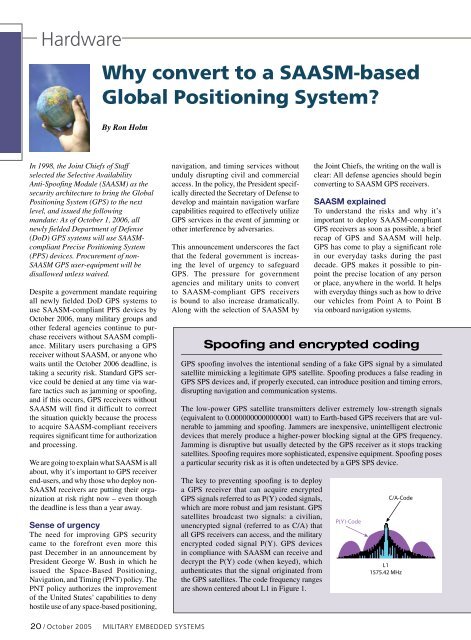Military Embedded Systems - Fall 2005 - Volume 1 Number 2
Military Embedded Systems - Fall 2005 - Volume 1 Number 2
Military Embedded Systems - Fall 2005 - Volume 1 Number 2
You also want an ePaper? Increase the reach of your titles
YUMPU automatically turns print PDFs into web optimized ePapers that Google loves.
Hardware<br />
Why convert to a SAASM-based<br />
Global Positioning System?<br />
By Ron Holm<br />
In 1998, the Joint Chiefs of Staff<br />
selected the Selective Availability<br />
Anti-Spoofing Module (SAASM) as the<br />
security architecture to bring the Global<br />
Positioning System (GPS) to the next<br />
level, and issued the following<br />
mandate: As of October 1, 2006, all<br />
newly fielded Department of Defense<br />
(DoD) GPS systems will use SAASMcompliant<br />
Precise Positioning System<br />
(PPS) devices. Procurement of non-<br />
SAASM GPS user-equipment will be<br />
disallowed unless waived.<br />
Despite a government mandate requiring<br />
all newly fielded DoD GPS systems to<br />
use SAASM-compliant PPS devices by<br />
October 2006, many military groups and<br />
other federal agencies continue to purchase<br />
receivers without SAASM compliance.<br />
<strong>Military</strong> users purchasing a GPS<br />
receiver without SAASM, or anyone who<br />
waits until the October 2006 deadline, is<br />
taking a security risk. Standard GPS service<br />
could be denied at any time via warfare<br />
tactics such as jamming or spoofing,<br />
and if this occurs, GPS receivers without<br />
SAASM will find it difficult to correct<br />
the situation quickly because the process<br />
to acquire SAASM-compliant receivers<br />
requires significant time for authorization<br />
and processing.<br />
We are going to explain what SAASM is all<br />
about, why it’s important to GPS receiver<br />
end-users, and why those who deploy non-<br />
SAASM receivers are putting their organization<br />
at risk right now – even though<br />
the deadline is less than a year away.<br />
Sense of urgency<br />
The need for improving GPS security<br />
came to the forefront even more this<br />
past December in an announcement by<br />
President George W. Bush in which he<br />
issued the Space-Based Positioning,<br />
Navigation, and Timing (PNT) policy. The<br />
PNT policy authorizes the improvement<br />
of the United States’ capabilities to deny<br />
hostile use of any space-based positioning,<br />
navigation, and timing services without<br />
unduly disrupting civil and commercial<br />
access. In the policy, the President specifically<br />
directed the Secretary of Defense to<br />
develop and maintain navigation warfare<br />
capabilities required to effectively utilize<br />
GPS services in the event of jamming or<br />
other interference by adversaries.<br />
This announcement underscores the fact<br />
that the federal government is increasing<br />
the level of urgency to safeguard<br />
GPS. The pressure for government<br />
agencies and military units to convert<br />
to SAASM-compliant GPS receivers<br />
is bound to also increase dramatically.<br />
Along with the selection of SAASM by<br />
the Joint Chiefs, the writing on the wall is<br />
clear: All defense agencies should begin<br />
converting to SAASM GPS receivers.<br />
SAASM explained<br />
To understand the risks and why it’s<br />
important to deploy SAASM-compliant<br />
GPS receivers as soon as possible, a brief<br />
recap of GPS and SAASM will help.<br />
GPS has come to play a significant role<br />
in our everyday tasks during the past<br />
decade. GPS makes it possible to pinpoint<br />
the precise location of any person<br />
or place, anywhere in the world. It helps<br />
with everyday things such as how to drive<br />
our vehicles from Point A to Point B<br />
via onboard navigation systems.<br />
Spoofing and encrypted coding<br />
GPS spoofing involves the intentional sending of a fake GPS signal by a simulated<br />
satellite mimicking a legitimate GPS satellite. Spoofing produces a false reading in<br />
GPS SPS devices and, if properly executed, can introduce position and timing errors,<br />
disrupting navigation and communication systems.<br />
The low-power GPS satellite transmitters deliver extremely low-strength signals<br />
(equivalent to 0.0000000000000001 watt) to Earth-based GPS receivers that are vulnerable<br />
to jamming and spoofing. Jammers are inexpensive, unintelligent electronic<br />
devices that merely produce a higher-power blocking signal at the GPS frequency.<br />
Jamming is disruptive but usually detected by the GPS receiver as it stops tracking<br />
satellites. Spoofing requires more sophisticated, expensive equipment. Spoofing poses<br />
a particular security risk as it is often undetected by a GPS SPS device.<br />
The key to preventing spoofing is to deploy<br />
a GPS receiver that can acquire encrypted<br />
GPS signals referred to as P(Y) coded signals,<br />
which are more robust and jam resistant. GPS<br />
satellites broadcast two signals: a civilian,<br />
unencrypted signal (referred to as C/A) that<br />
all GPS receivers can access, and the military<br />
encrypted coded signal P(Y). GPS devices<br />
in compliance with SAASM can receive and<br />
decrypt the P(Y) code (when keyed), which<br />
authenticates that the signal originated from<br />
the GPS satellites. The code frequency ranges<br />
are shown centered about L1 in Figure 1.<br />
P(Y)-Code<br />
C/A-Code<br />
L1<br />
1575.42 MHz<br />
20 / October <strong>2005</strong> <strong>Military</strong> EMBEDDED SYSTEMS
















